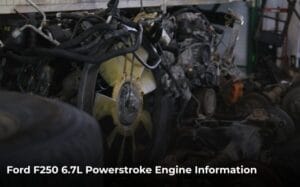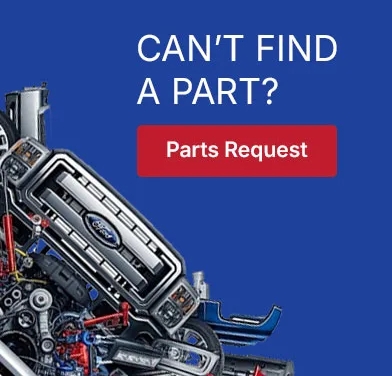Ford F250 F350 6.7L Powerstroke Engine Specs – Everything You Ever Wanted to Know
 Everything you ever wanted to know about the 6.7L Powerstroke Engine. Buckle Up.
Everything you ever wanted to know about the 6.7L Powerstroke Engine. Buckle Up.
- Introduced in 2011 as Ford’s first in-house designed heavy-duty diesel (replacing Navistar-built Powerstrokes).
- Known for durability, torque output, and towing capability.
- Engineered for both power and emissions compliance (DEF/SCR system).
Core Specifications
- Displacement: 6.7 liters (406 cu in)
- Configuration: 90° V8, OHV (overhead valve)
- Block Material: Compacted Graphite Iron (CGI) for strength and reduced weight
- Heads: Aluminum alloy with four valves per cylinder
- Bore x Stroke: 3.9 in × 4.25 in (99 mm × 108 mm)
Compression Ratio: ~16.2:1 (varies slightly by year) - Firing Order: 1-2-7-3-4-5-6-8
Fuel & Air Systems
- Fuel Injection: High-pressure common rail direct injection (29,000+ psi) with piezoelectric injectors
- Turbocharger:
- Early (2011–2014): Single dual-sided compressor turbo (unique design)
- Later (2015–present): Traditional single-sequential turbo with variable geometry for improved reliability
- Intake Manifold: Composite/plastic for reduced weight and improved airflow
- EGR System: Exhaust gas recirculation with coolers to reduce NOx emissions
- Air-to-air intercooler for charge cooling
Exhaust & Emissions
- DPF (Diesel Particulate Filter): Captures soot, burns it off in regen cycles
- SCR (Selective Catalytic Reduction): Uses DEF (Diesel Exhaust Fluid) injection to neutralize NOx emissions
- DOC (Diesel Oxidation Catalyst): Assists in reducing carbon monoxide and unburned hydrocarbons
Lubrication & Cooling
- Oil System: High-pressure oil system with piston cooling jets
- Cooling System: High-capacity water pump, dual thermostats, large-capacity radiators
- Oil Cooler: Engine-mounted liquid-to-liquid cooler
One quick item to mention here, pay special attention to the Upper Oil pan seal on these 6.7L Powerstrokes as it likes to spring leaks. Whenther you own one or are considering buying one, these seals tend to go out and the repair is no fun.
Internal Components
- Crankshaft: Forged steel, cross-bolted mains
- Connecting Rods: Forged, high-strength steel
- Pistons: Cast-aluminum with steel ring inserts and oil cooling galleries
- Valvetrain: Pushrod-actuated, roller lifters, rocker arms
Performance by Year
- 2011–2014: 390 hp / 735 lb-ft
- 2015–2016: 440 hp / 860 lb-ft
- 2017: 440 hp / 925 lb-ft
- 2018–2019: 450 hp / 935 lb-ft
- 2020–2022: 475 hp / 1,050 lb-ft (industry-leading torque at the time)
Engine Diagrams
If you are looking for a specific engine diagram, we can provide them to you. Otherwise, Diesel Mechanic does a great job breaking down the individual components of this engine in further detail. Visit their website to see labeled images for many different engine angles, including information about the following components:
- Air Inlet from air filter
- Exhaust Gas Recirculation (EGR) cooler outlet temperature sensor
- Front Engine Accessory Drive (FEAD) idler pulley
- Camshaft Position (CMP) sensor
- Primary coolant pump
- Air inlet from Charge Air Cooler (CAC)
- Intake throttle body
- Primary water pump
- Wastegate control solenoid
- Oil level indicator
- Fuel Rail Pressure (FRP) sensor
- Engine oil cooler
- Fuel return line
- Crankcase vent oil separator
- Water pump inlet
- Crankshaft Position (CKP) sensor
- Wastegate actuator
- Turbocharger Exhaust Supply
- Spin-on oil filter
- Turbo Outlet Pipe (Cobra Head)
- Exhaust Pressure (EP) sensor
- Variable Geometry Turbocharger (VGT) actuator
- Block heater
- EGR cooler
- Oil pressure switch
- Engine Oil Temperature (EOT) sensor
- Engine Coolant Temperature 2 (ECT2) sensor
- EGR valve
- EGR valve motor with position sensor
- Engine Coolant Temperature (ECT) sensor
- Wastegate control vacuum solenoid
- Fuel Rail Temperature (FRT) sensor
- Fuel Pressure Switch (FPS)
- Engine-mounted fuel filter
- Fuel supply line
- Injector Quantity Adjustment (IQA) sticker
- Turbocharger compressor outlet
- Manifold Absolute Pressure (MAP) sensor
- Exhaust Pressure (EP) sensor
- Heater core supply
- EGR cooler secondary coolant inlet
- EGR cooler secondary coolant outlet
- EGR cooler bypass solenoid
- EGR valve motor and position sensor
Recommended Oil for the 6.7L Diesel
Viscosity:
- SAE 10W-30 (preferred for most operating conditions, especially for fuel economy)
- SAE 15W-40 (recommended for sustained high-load/towing, or in high-temperature environments)
Specification:
- Must meet Ford WSS-M2C171-F1 specification
- Also meets API CK-4 (or newer) diesel oil standards
Brand:
- Motorcraft® SAE 10W-30 Superduty Diesel Motor Oil is the factory fill and primary recommendation
- Motorcraft® SAE 15W-40 Superduty Diesel Motor Oil also approved
Capacity
- Approximately 13 quarts (12.3 liters) with oil filter change
Recommended Fuel Filter Setup for the Powerstroke
Ford recommends using Motorcraft® fuel filter kits specifically designed for the 6.7 L Powerstroke engine for optimized filtration, durability, and fitment.
- For model years 2011–2016:
Part numbers BC3Z‑9N184‑B or FD‑4615 are the OEM Motorcraft fuel filter replacements. - For model years 2017 and newer (up to at least 2023+):
The updated Motorcraft kit part numbers include FD‑4625, FD‑4641, and variants such as LC3Z‑9N184‑A and HC3Z‑9N184‑C.
These kits typically include both the primary filter element and the fuel/water separator, as the 6.7 L setup uses a two-stage system to manage particulates and moisture effectively. Ford emphasizes that only Motorcraft® diesel fuel filters are recommended for this engine, citing their tested efficiency, capacity, and balance to avoid both under-filtering and over-filtering in diesel applications. Additionally, the aluminum housing for the filter (particularly for the upper filter) is known to be a failure point, potentially cracking and leaking when non-OEM filters or poor-quality housings are used.
Ford Superduty OEM Air Filter Recommendation
Motorcraft® Air Filter (factory part)
- Ford strongly recommends using Motorcraft OEM filters, since they are specifically engineered for the 6.7’s intake system and filtration requirements.
- Motorcraft air filters meet Ford’s spec for filtration efficiency and restriction (balance of maximum dirt-trapping with minimum airflow restriction).
Part Numbers by Year
- 2011–2016: Motorcraft FA-1902 (Ford PN: BC3Z-9601-A)
- 2017–2019: Motorcraft FA-1927 (Ford PN: HC3Z-9601-A)
- 2020–2022: Motorcraft FA-2031 (Ford PN: LC3Z-9601-A)
Not recommended: Oiled gauze (e.g., standard K&N) filters. The 6.7L’s mass air flow (MAF) and turbo system are very sensitive to fine dust bypass. Ford and most diesel techs warn that aftermarket oiled filters can allow higher dust ingress and damage the turbocharger and engine.
Engine Service Intervals
- Replace air filter every 30,000 miles under normal driving.
- Replace more frequently in dusty/off-road conditions (sometimes as often as 10–15k miles).
- The 6.7’s airbox has a filter restriction gauge on top—check it regularly, and replace if restriction reaches the red zone.
Known Failure Points on the 6.7L Powerstroke
Fuel System
CP4 High-Pressure Fuel Pump (HPFP)
- Used 2011–2020, very sensitive to poor fuel quality or water contamination.
- When it fails, it can send metal shavings through the entire fuel system, requiring replacement of pump, injectors, lines, and rails.
- Ford switched to a DCR pump in 2020+, which is more reliable.
Fuel Filters
- If neglected, can accelerate pump wear or injector damage.
Turbocharger
- 2011–2014 dual-sided compressor turbo (unique design):
- Known to fail prematurely due to design flaws and excessive heat.
- Replaced in 2015 with a conventional Garrett single-sequential variable geometry turbo that is much more durable.
- Wastegate actuators and VGT actuators (electronic) can also fail.
EGR & Emissions Systems
EGR Coolers and Valves
- prone to clogging, sticking, or cracking, especially if truck does lots of short trips.
DPF (Diesel Particulate Filter)
- can plug up if regeneration cycles are interrupted often.
DEF (Diesel Exhaust Fluid) System
- heaters, sensors, and pumps are known weak points. Failures often trigger derate/limp mode.
Cooling System
Radiators (2011–2016)
- prone to cracking at the plastic/aluminum seams.
Coolant leaks
- Leaks from water pumps and thermostats are relatively common.
Oil Cooler
- Cooler can clog internally if coolant isn’t maintained, leading to higher oil temps.
Sensors & Electronics
NOx Sensors
- These (part of emissions system) frequently fail and are expensive.
Exhaust Back Pressure (EBP) Sensor and EGR Sensors
- These can become clogged with soot.
Glow Plug Control Module
- These occasionally fails, causing hard starts in cold weather.
Engine Internals
Overall very stout design (CGI block, forged internals), but:
Rocker Arm Assemblies
- have been known to fail in some cases.
Lifter Failure
- is rare but catastrophic when it happens (often from lack of oil maintenance).
Note: Far fewer issues here compared to the 6.0L/6.4L predecessors.
Model Year–Specific Notes
- 2011–2014: Turbo design and radiators are the biggest weaknesses.
- 2015–2016: Stronger turbo, but emissions components still problematic.
- 2017–2019: Reliability improved, but CP4 fuel pump still a ticking time bomb.
- 2020+ (Gen 3 engine): Much improved with DCR fuel pump and updated turbo; emissions system still main pain point.
CP4 Pump Conversion – Do It!!!
In this engine, the CP4 is a common-rail injection pump, a high-pressure fuel pump. It serves to create and regulate the high-pressure fuel needed for the engine’s common-rail injection system, delivering precise fuel amounts at the appropriate pressure to the engine’s injectors. The factory version of this pump is not designed well and can ruin your motor sending shards or metal throught the engine. Therefore, we recommend replacing it with the SPE Motorsport CP3 Conversion Kit. We usually only stick with OEM information, but in this case we will make an exception and mention a great fix for the CP3 issue. Just make sure you make this upgrade before your pump takes a sh!t.
What it is?
A full replacement system that swaps the factory CP4 pump for a CP3 pump, driven by a serpentine belt instead of the crank gear. It’s a bolt-on upgrade designed to eliminate the known weaknesses of the CP4 system.
Key Benefits:
- Moves fuel pump load off the crank gear and onto the serpentine system, reducing risk of gear slippage under heavy duty use.
- Improves accessibility—pump is removed from the valley, making service quicker and easier.
- No tuning or wiring modifications required; retains all factory fuel lines, vacuum pump, and wiring connections.
- Supports OEM CP3 pump availability—simple to source replacements.
- Designed to maintain equivalent fuel volume and flow, leveraging the CP3’s reliability without lowering performance.
- Compatible with model years 2011 through 2025 (F‑250, F‑350, F‑450).
Routine Engine Maintenance Intervals
Engine Oil & Filter
- Interval: Every 7,500 miles or 6 months under normal service.
- Severe duty (towing, idling, dusty/off-road, biodiesel use): Every 5,000 miles.
- Capacity: ~13 quarts with filter.
- Oil Spec: Motorcraft® Superduty Diesel 10W-30 (preferred) or 15W-40, meeting Ford WSS-M2C171-F1 / API CK-4.
Fuel Filters (Primary & Secondary)
- Interval: Every 15,000 miles or every other oil change.
- Diesel is prone to water/contamination, so Ford emphasizes replacing both filters together.
- Always drain the water separator at oil change intervals.
Air Filter
- Interval: Inspect at 30,000 miles, replace if dirty.
- More frequent replacement in dusty/off-road conditions.
- Truck includes a restriction gauge on the airbox — replace when in the red zone, even if under 30k miles.
Coolant
- Interval: Every 105,000 miles or 6 years initially, then every 45,000 miles or 3 years after.
- Use Motorcraft® Yellow (2011–2018) or Motorcraft® Specialty Orange (2019+) coolant, depending on model year.
- Always check hoses, degas bottle, and radiator for leaks (early radiators prone to failure 2011–2016).
Serpentine Belt
- Inspect every 60,000 miles.
- Replace around 100,000–120,000 miles (or sooner if cracked/noisy).
Glow Plugs & Control Module
- Inspect during routine service.
- Typically last 100,000+ miles, but hard cold starts may indicate failure earlier.
Special Service Items
- PCV / Crankcase Vent Filter: Replace every 67,500 miles.
- DEF (Diesel Exhaust Fluid): Refill as needed (typically every 3,000–5,000 miles depending on driving).
- Emissions Components (DPF, EGR, SCR): No set replacement, but expect inspection/cleaning around 120,000–150,000 miles if issues arise.
Recalls / Special Service Bulletins
These recalls are for components related to the 6.7L Powerstroke engine:
24S78 (NHTSA 24V-957) — 2020–2022 F-250/F-350/F-450/F-550/F-600 & 2021–2022 F-650/F-750 with 6.7L
Issue: High-pressure fuel pump (HPFP) can fail over time due to aged biodiesel deposits, causing loss of motive power.
Remedy: PCM software update to increase pump cooling; owner notifications began January 2025.
22S01 (NHTSA 22V-013) — 2021 F-250/F-350/F-450/F-550/F-600 & 2021 F-650/F-750 with 6.7L
Issue: A molding void in the secondary (under-hood) fuel-filter cap can become a pinhole and leak fuel, creating a fire risk.
Remedy: Replace both primary and secondary fuel filters with updated parts.
18S45 (NHTSA 18V-894) — 2017–2019 Superduty (diesel trucks equipped with an engine block heater)
Issue: Water intrusion into the block-heater cable splice can cause corrosion/short and potential fire when plugged in.
Remedy: Inspect, seal, and if necessary replace the block-heater cable.
25V455 (filed July 2025) — 2021–2023 F-Series Superduty (various engines; includes certain diesel trucks)
Issue: Low-pressure fuel pump (Fuel Delivery Module) can fail due to internal contamination of the jet pump, leading to stalling.
Remedy: Owner letters mailed July 2025; remedy in development (performed free once available).
EGR Delete
If you are considering an EGR Delete, have a look at the information below. Here’s a detailed look at what’s involved with an EGR (Exhaust Gas Recirculation) delete for the 6.7L Powerstroke engine, including how it’s done, the pros and cons, and legal considerations:
What Does an EGR Involve?
An EGR delete involves removing or disabling the engine’s exhaust gas recirculation system. Typical delete kits include:
- Block-off plates for the EGR valve, cooler, and associated piping
- Coolant hose reroutes to bypass the cooling circuit
- Gaskets and hardware for leak-free installation
- Often combined with DPF/DEF delete components and necessary tuning calibrations.
Benefits of Deleting the EGR
- Performance Gains: Boost horsepower and torque—typically an additional 10–20 hp, especially when accompanied by tuning.
- Improved Fuel Efficiency: Reduces soot build-up and combustion heat, helping fuel economy.
- Reduced Maintenance: Eliminates common EGR-related issues like cooler clogging and failures.
Downsides & Risks
- Legal Issues: Removing EGR violates U.S. EPA regulations and is illegal for street-driven vehicles.
- Voided Warranty: Ford may deny warranty claims if emissions tampering is detected.
- Reduced Resale Value: Non-compliant trucks can be harder to sell.
- Check Engine Light (CEL): Unless reprogrammed with a proper tune, missing EGR triggers fault codes and may cause limp mode.
In Summary
Overall the 6.7L Powerstroke is one of our favorite motors Ford has ever built. If you are considering buying a Superduty, do yourself a favor and look for this engine. Just make sure to do your due-diligence on it first.
The 7.3L Diesel is also an old school super star as lnog as you maintain it well. For more information about this engine and some of the others, fell free to contact us. We’re happy to provide any info you may need.
The Patriotic Philosopher of Possum County Billy Hill is what happens when a six-pack of root beer, a John Deere hat, and the U.S. Constitution have a baby in the back of a pickup truck. Hailing from the grand hills of somewhere-between-here-and-there, Billy proudly considers himself a “hillbilly” — but with a PhD in common sense and a minor in wrestling raccoons off his porch. With a mullet that flows like a bald eagle in slow motion and a wardrobe that screams “Walmart clearance aisle patriotism,” Billy doesn’t just love America — he is America. He celebrates the 4th of July so hard his neighbors file noise complaints with the bald eagle sanctuary three counties over. Billy’s life philosophy is simple: “If it ain’t broke, duct tape it anyway for extra freedom.” He doesn’t take life too seriously because, as he puts it, “Ain’t no point stressin’ when you got barbecue sauce and a recliner.” He believes everything in life can be solved with a grill, a beer, or a rousing debate about which state has the best gas station snacks. Billy once tried to start his own political party: The Red, White, and Brew Party: its platform consisting entirely of fireworks, lawn chairs, and banning low-fat anything. Whether he’s hunting invisible squirrels in flip-flops or giving unsolicited wisdom like “You can’t buy happiness, but you can buy bacon,” Billy Hill is the national treasure no one asked for, but America somehow deserves.


